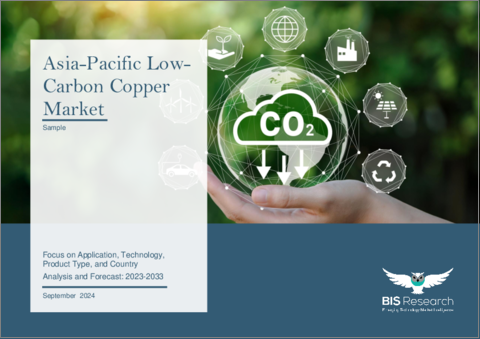|
|
市場調査レポート
商品コード
1553409
アジア太平洋の低炭素銅市場:用途別、技術別、製品タイプ別、国別 - 分析と予測(2023年~2033年)Asia-Pacific Low-Carbon Copper Market: Focus on Application, Technology, Product Type, and Country - Analysis and Forecast, 2023-2033 |
||||||
カスタマイズ可能
|
|||||||
| アジア太平洋の低炭素銅市場:用途別、技術別、製品タイプ別、国別 - 分析と予測(2023年~2033年) |
|
出版日: 2024年09月12日
発行: BIS Research
ページ情報: 英文 66 Pages
納期: 1~5営業日
|
全表示
- 概要
- 図表
- 目次
アジア太平洋の低炭素銅の市場規模は、2023年の463億5,000万米ドルから2033年には1,014億9,000万米ドルに達し、予測期間の2023年~2033年のCAGRは8.15%になると予測されています。
この地域一帯の政府が実施している厳しい環境規制が、アジア太平洋における低炭素銅の普及を促進すると予想されます。このような規則により、より環境にやさしく持続可能な採掘・抽出方法が奨励されるため、低炭素銅の市場は拡大しています。政府も特に先進地域では、環境にやさしい製造工程に投資する企業にインセンティブを与えています。生産量、効果、持続可能性、拡張性を高める技術革新は、この分野でもっと普及するはずです。二酸化炭素排出量を減らし、持続可能なサプライチェーンを推進したいという願望が、低炭素銅の需要を押し上げると予想されます。より多くの企業が持続可能性の目標を設定し、環境への配慮を計画に盛り込むからです。
| 主要市場統計 | |
|---|---|
| 予測期間 | 2023年~2033年 |
| 2023年の評価 | 463億5,000万米ドル |
| 2033年の予測 | 1,014億9,000万米ドル |
| CAGR | 8.15% |
アジア太平洋の低炭素銅市場は、同地域の厳しい環境法や持続可能性プログラムの採用により、大きく拡大しています。アジア太平洋の各国政府が気候変動に対処するためにより厳しい環境規制を課し、よりクリーンな工業プロセスを奨励しているため、低炭素銅のニーズは高まっています。この銅はより環境にやさしい方法で作られたものであるため、より環境にやさしい技術への移行を促し、温室効果ガスの排出を抑えることができるのです。
産業界はこうした規制を受け、法的要求や企業の持続可能な目標に応えるため、低炭素銅への投資を増やしています。銅の生産効率を上げ、二酸化炭素排出量を減らすという技術開発が、この市場拡大の促進要因となっています。環境にやさしいやり方やイノベーションを実践している企業に対する政府の奨励金も需要増に貢献しています。
低炭素銅市場は、アジア太平洋が環境への影響を最小限に抑え、より持続可能な未来に向かうことを強調し続ける限り、急速に拡大すると予想されます。低炭素銅への移行は、持続可能な開発目標を達成し、サプライチェーンの強靭性を強化し、再生可能エネルギー、エレクトロニクス、建設など、さまざまな産業で高まる環境にやさしい素材への需要を満たすために不可欠です。
当レポートでは、アジア太平洋の低炭素銅市場について調査し、市場の概要とともに、用途別、技術別、製品タイプ別、国別の動向、および市場に参入する企業のプロファイルなどを提供しています。
目次
エグゼクティブサマリー
第1章 市場
- 動向:現在および将来の影響評価
- サプライチェーンの概要
- 研究開発レビュー
- 規制状況
- ステークホルダー分析
- 市場力学の概要
- スタートアップ資金調達の概要
第2章 地域
- 地域別概要
- 促進要因と抑制要因
- アジア太平洋
第3章 市場-競合ベンチマーキングと企業プロファイル
- 今後の見通し
- 地理的評価
- LS MnM Inc.
- JX Metals Corporation
- Zijin Mining Group Co., Ltd.
- BHP
- Environmental Copper Recovery SA Pty Ltd.
第4章 調査手法
List of Figures
- Figure 1: Region with the Largest Share of Market, 2022, 2026, and 2033
- Figure 2: Asia-Pacific Low-Carbon Copper Market (by Technology), 2022, 2026, and 2033
- Figure 3: Asia-Pacific Low-Carbon Copper Market (by Product Type), 2022, 2026, and 2033
- Figure 4: low-carbon copper, Recent Developments
- Figure 5: Supply Chain and Risks within the Supply Chain
- Figure 6: Low-Carbon Copper Market (by Country), January 2020-December 2023
- Figure 7: Impact Analysis of Market Navigating Factors, 2023-2033
- Figure 8: China Low-Carbon Copper Market, $Million, 2022-2033
- Figure 9: Japan Low-Carbon Copper Market, $Million, 2022-2033
- Figure 10: South Korea Low-Carbon Copper Market, $Million, 2022-2033
- Figure 11: India Low-Carbon Copper Market, $Million, 2022-2033
- Figure 12: Rest-of-Asia-Pacific Low-Carbon Copper Market, $Million, 2022-2033
- Figure 13: Strategic Initiatives, 2021-2023
- Figure 14: Share of Strategic Initiatives, 2021-2023
- Figure 15: Data Triangulation
- Figure 16: Top-Down and Bottom-Up Approach
- Figure 17: Assumptions and Limitations
List of Tables
- Table 1: Market Snapshot
- Table 2: Low-Carbon Copper Market, Opportunities/Risks
- Table 3: Low-Carbon Copper Market (by Region), $Million, 2022-2033
- Table 4: Asia-Pacific Low-Carbon Copper Market (by Application), $Million, 2022-2033
- Table 5: Asia-Pacific Low-Carbon Copper Market (by Technology), $Million, 2022-2033
- Table 6: Asia-Pacific Low-Carbon Copper Market (by Product Type), $Million, 2022-2033
- Table 7: China Low-Carbon Copper Market (by Application), $Million, 2022-2033
- Table 8: China Low-Carbon Copper Market (by Technology), $Million, 2022-2033
- Table 9: China Low-Carbon Copper Market (by Product Type), $Million, 2022-2033
- Table 10: Japan Low-Carbon Copper Market (by Application), $Million, 2022-2033
- Table 11: Japan Low-Carbon Copper Market (by Technology), $Million, 2022-2033
- Table 12: Japan Low-Carbon Copper Market (by Product Type), $Million, 2022-2033
- Table 13: South Korea Low-Carbon Copper Market (by Application), $Million, 2022-2033
- Table 14: South Korea Low-Carbon Copper Market (by Technology), $Million, 2022-2033
- Table 15: South Korea Low-Carbon Copper Market (by Product Type), $Million, 2022-2033
- Table 16: India Low-Carbon Copper Market (by Application), $Million, 2022-2033
- Table 17: India Low-Carbon Copper Market (by Technology), $Million, 2022-2033
- Table 18: India Low-Carbon Copper Market (by Product Type), $Million, 2022-2033
- Table 19: Rest-of-Asia-Pacific Low-Carbon Copper Market (by Application), $Million, 2022-2033
- Table 20: Rest-of-Asia-Pacific Low-Carbon Copper Market (by Technology), $Million, 2022-2033
- Table 21: Rest-of-Asia-Pacific Low-Carbon Copper Market (by Product Type), $Million, 2022-2033
- Table 22: Market Share
Introduction to Asia-Pacific Low-Carbon Copper Market
The Asia-Pacific low-carbon copper market is projected to reach $101.49 billion by 2033 from $46.35 billion in 2023, growing at a CAGR of 8.15% during the forecast period 2023-2033. The strict environmental regulations that governments throughout the region have implemented are expected to drive uptake of low-carbon copper in APAC. Because of these rules, which encourage more environmentally friendly and sustainable methods of mining and extraction, the market for low-carbon copper is growing. Governments are also providing incentives, especially in developed regions, to companies that invest in environmentally friendly manufacturing processes. Innovations in technology that increase output, effectiveness, sustainability, and scalability should become more popular in this field. The desire to lessen carbon footprints and promote sustainable supply chains is expected to drive up demand for low-carbon copper as more businesses set sustainability goals and include environmental concerns into their plans.
Market Introduction
| KEY MARKET STATISTICS | |
|---|---|
| Forecast Period | 2023 - 2033 |
| 2023 Evaluation | $46.35 Billion |
| 2033 Forecast | $101.49 Billion |
| CAGR | 8.15% |
APAC's low-carbon copper market is expanding significantly as a result of the region's adoption of strict environmental laws and sustainability programs. The need for low-carbon copper is growing as governments in Asia-Pacific impose more stringent environmental regulations to tackle climate change and encourage cleaner industrial processes. Because it was made with more environmentally friendly practices, this copper helps to promote the transition to greener technologies and lowers greenhouse gas emissions.
Industries are investing more in low-carbon copper in response to these regulations in order to comply with legal requirements and corporate sustainability objectives. Technological developments in copper production that increase efficiency and lower carbon footprints are the driving force behind this market expansion. Government incentives for companies implementing eco-friendly practices and innovations also contribute to the increase in demand.
The low-carbon copper market is expected to expand rapidly as long as APAC keeps emphasizing minimizing its environmental effect and moving toward a more sustainable future. The transition to low-carbon copper is essential for achieving sustainable development objectives, strengthening the resilience of supply chains, and satisfying the growing demand for eco-friendly materials in a variety of industries, such as renewable energy, electronics, and construction.
Market Segmentation:
Segmentation 1: by End-Use Application
- Power Generation and Distribution
- Building and Construction
- Consumer Electronics
- Automotive
- Others
Segmentation 2: by Technology
- Pyrometallurgy
- Hydrometallurgy
Segmentation 3: by Product Type
- Recycled Low-Carbon Copper
- Virgin Low-Carbon Copper
Segmentation 4: by Country
- China
- India
- Japan
- South Korea
- Rest-of-Asia-Pacific
How can this report add value to an organization?
Product/Innovation Strategy: This report provides a comprehensive product/innovation strategy for the Asia-Pacific low carbon copper market, identifying opportunities for market entry, technology adoption, and sustainable growth. It offers actionable insights, helping organizations leverage low carbon copper to meet environmental standards, gain a competitive edge, and capitalize on the increasing demand for eco-friendly solutions in various industries.
Growth/Marketing Strategy: This report offers a comprehensive growth and marketing strategy designed specifically for the Asia-Pacific low carbon copper market. It presents a targeted approach to identifying specialized market segments, establishing a competitive advantage, and implementing creative marketing initiatives aimed at optimizing market share and financial performance. By harnessing these strategic recommendations, organizations can elevate their market presence, seize emerging prospects, and efficiently propel revenue expansion.
Competitive Strategy: This report crafts a strong competitive strategy tailored to the Asia-Pacific low carbon copper market. It evaluates market rivals, suggests methods to stand out, and offers guidance for maintaining a competitive edge. By adhering to these strategic directives, companies can position themselves effectively in the face of market competition, ensuring sustained prosperity and profitability.
Key Market Players and Competition Synopsis
The companies that are profiled in the report have been selected based on inputs gathered from primary experts and analyzing company coverage, product portfolio, and market penetration.
Some of the prominent names in this market are:
- LS MnM Inc.
- JX Metals Corporation
- Zijin Mining Group Co., Ltd.
- BHP
Table of Contents
Executive Summary
Scope and Definition
1 Markets
- 1.1 Trends: Current and Future Impact Assessment
- 1.1.1 Trends: Current and Future Impact Assessment
- 1.1.2 Trend 1: Increased Demand from Key Industries
- 1.1.3 Trend 2: Rise of Electric Vehicles (EVs)
- 1.1.4 Trend 3: Sustainability and Recycling Efforts
- 1.2 Supply Chain Overview
- 1.2.1 Market Map
- 1.3 Research and Development Review
- 1.3.1 Patent Filing Trend (by Country)
- 1.4 Regulatory Landscape
- 1.4.1 Consortiums and Associations
- 1.4.2 Regulatory Bodies
- 1.4.3 Government Programs
- 1.5 Stakeholder Analysis
- 1.6 Market Dynamics Overview
- 1.6.1 Market Drivers
- 1.6.1.1 Consumer Demand for Sustainable Products
- 1.6.1.2 Automotive Industry's Adoption of Low-Carbon Copper for Electric Vehicles and Beyond
- 1.6.1.3 Environmental Regulations and Policies
- 1.6.2 Market Restraints
- 1.6.2.1 High Cost of Production
- 1.6.2.2 Supply Chain Challenges
- 1.6.3 Market Opportunities
- 1.6.3.1 Sustainability and Recycling Practices
- 1.6.3.2 Integration of Industry 4.0 Technologies
- 1.6.1 Market Drivers
- 1.7 Startup Funding Summary
2 Regions
- 2.1 Regional Summary
- 2.2 Drivers and Restraints
- 2.3 Asia-Pacific
- 2.3.1 Regional Overview
- 2.3.2 Driving Factors for Market Growth
- 2.3.3 Factors Challenging the Market
- 2.3.3.1 Application
- 2.3.3.2 Product
- 2.3.4 China
- 2.3.4.1 Application
- 2.3.4.2 Product
- 2.3.5 Japan
- 2.3.5.1 Application
- 2.3.5.2 Product
- 2.3.6 South Korea
- 2.3.6.1 Application
- 2.3.6.2 Product
- 2.3.7 India
- 2.3.7.1 Application
- 2.3.7.2 Product
- 2.3.8 Rest-of-Asia-Pacific
- 2.3.8.1 Application
- 2.3.8.2 Product
3 Markets - Competitive Benchmarking & Company Profiles
- 3.1 Next Frontiers
- 3.2 Geographic Assessment
- 3.2.1 LS MnM Inc.
- 3.2.1.1 Overview
- 3.2.1.2 Top Products/Product Portfolio
- 3.2.1.3 Top Competitors
- 3.2.1.4 Target Customers
- 3.2.1.5 Key Personnel
- 3.2.1.6 Analyst View
- 3.2.1.7 Market Share, 2022
- 3.2.2 JX Metals Corporation
- 3.2.2.1 Overview
- 3.2.2.2 Top Products/Product Portfolio
- 3.2.2.3 Top Competitors
- 3.2.2.4 Target Customers
- 3.2.2.5 Analyst View
- 3.2.2.6 Market Share, 2022
- 3.2.3 Zijin Mining Group Co., Ltd.
- 3.2.3.1 Overview
- 3.2.3.2 Top Products/Product Portfolio
- 3.2.3.3 Top Competitors
- 3.2.3.4 Target Customers
- 3.2.3.5 Key Personnel
- 3.2.3.6 Analyst View
- 3.2.3.7 Market Share, 2022
- 3.2.4 BHP
- 3.2.4.1 Overview
- 3.2.4.2 Top Products/Product Portfolio
- 3.2.4.3 Top Competitors
- 3.2.4.4 Target Customers
- 3.2.4.5 Key Personnel
- 3.2.4.6 Analyst View
- 3.2.4.7 Market Share, 2022
- 3.2.5 Environmental Copper Recovery SA Pty Ltd.
- 3.2.5.1 Overview
- 3.2.5.2 Top Products/Product Portfolio
- 3.2.5.3 Top Competitors
- 3.2.5.4 Target Customers
- 3.2.5.5 Analyst View
- 3.2.5.6 Market Share, 2022
- 3.2.1 LS MnM Inc.
4 Research Methodology
- 4.1 Data Sources
- 4.1.1 Primary Data Sources
- 4.1.2 Secondary Data Sources
- 4.1.3 Data Triangulation
- 4.2 Market Estimation and Forecast





